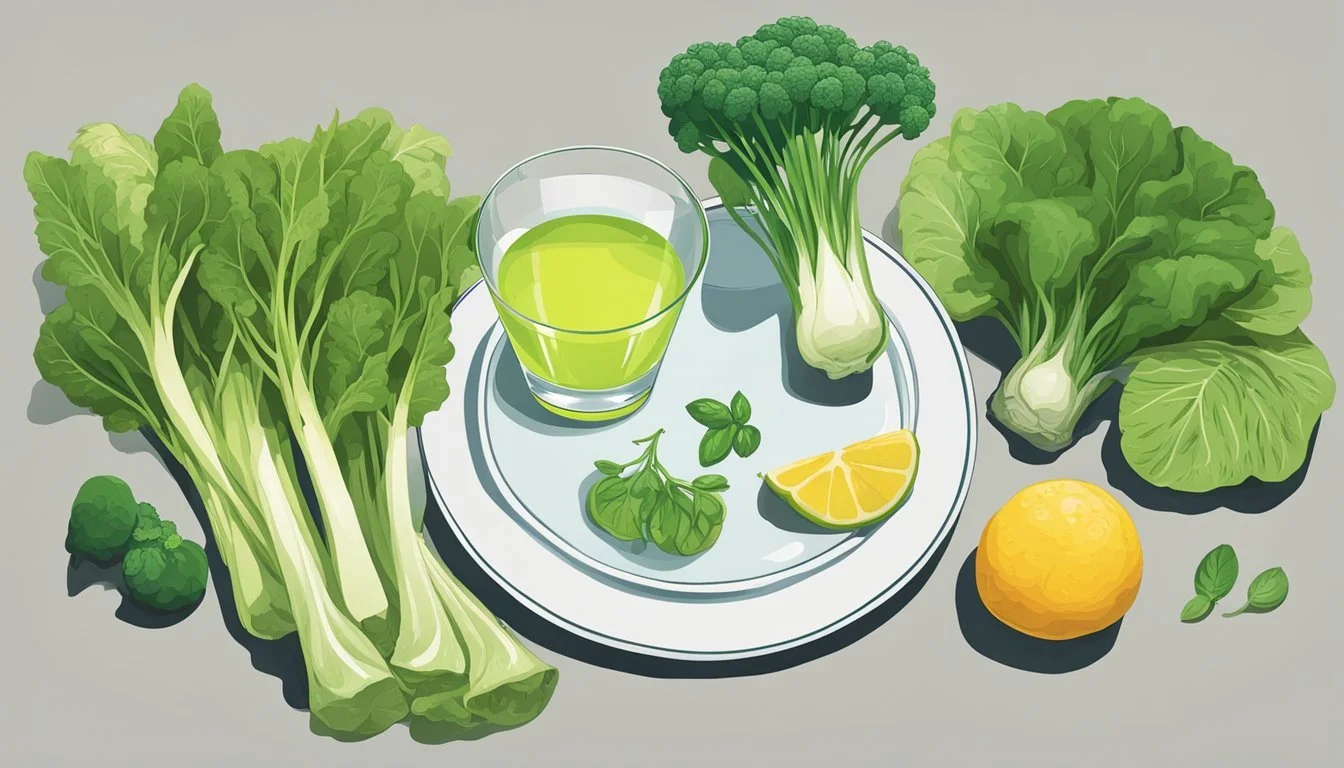Soothing Foods That Help Tame Acid Reflux Naturally
Acid reflux, a common condition characterized by a burning sensation in the chest, often affects many individuals. It can be triggered by various factors, including diet. Understanding which foods can help alleviate these symptoms is crucial for those who suffer from this discomfort. By incorporating specific dietary choices, individuals can significantly reduce the frequency and severity of acid reflux episodes.
The focus of this article is to explore different foods that have been shown to help manage and mitigate the symptoms of acid reflux. While the condition can be influenced by several lifestyle changes, modifying one's diet plays a key role in controlling its impact.
1) Ginger Tea
Ginger tea is a popular natural remedy for acid reflux. Known for its anti-inflammatory properties, ginger can help reduce the irritation in the esophagus associated with acid reflux.
Ginger is available in various forms, including fresh roots, powder, and tea bags. When prepared as a tea, it can be a soothing option for those experiencing heartburn symptoms.
The key active compound in ginger, gingerol, may help improve gastric motility. This could potentially prevent the onset of acid reflux by ensuring the stomach contents move smoothly through the digestive tract.
Due to its natural properties, ginger tea can be included in a regular diet. For optimal benefits, consuming it in moderate amounts is advisable. Excessive intake of ginger, over 6 grams per day, can lead to adverse effects.
2) Oatmeal
Oatmeal is a highly recommended food for those experiencing acid reflux. It is rich in fiber, which can help absorb stomach acid. Fiber aids digestion by promoting regular bowel movements and preventing constipation.
Oatmeal is known for its versatility. It can be flavored with fruits like bananas or apples, which are less likely to trigger acid reflux.
The soothing texture of oatmeal can also coat the stomach lining, providing a barrier against acid irritation. Unlike some breakfast options, oatmeal lacks irritating ingredients that may exacerbate reflux symptoms.
For an added health boost, consider adding a touch of honey or a handful of nuts, but avoid using high-fat dairy or sugary toppings. These can sometimes worsen acid reflux.
Incorporating oatmeal into breakfast routines can be a simple yet effective way for individuals to manage their acid reflux symptoms.
3) Bananas
Bananas are often recommended for individuals suffering from acid reflux. Their natural antacid properties can help neutralize stomach acid and provide relief from discomfort.
Ripe bananas are especially beneficial. They are less acidic compared to other fruits, making them a suitable option for those with sensitive stomachs.
In addition, bananas are rich in pectin, a soluble fiber. Pectin facilitates smooth movement of the stomach contents through the digestive tract, reducing the chances of acid reflux.
Bananas also contain essential nutrients such as potassium and magnesium. These minerals support overall digestive health, contributing to the reduction of acid reflux symptoms.
Eating a banana as a snack or incorporating it into meals can be a simple way to alleviate acid reflux. Their mild flavor and soft texture make them versatile and easy to digest.
Incorporating bananas into a balanced diet can help manage acid reflux symptoms effectively.
4) Melons
Melons, such as watermelon, cantaloupe, and honeydew, are excellent choices for those seeking relief from acid reflux. These fruits are low in acidity, which reduces the likelihood of irritating the esophagus.
The high water content in melons helps dilute stomach acid, making them easier to digest. Watermelon, for example, is made up of 92 percent water, which aids in hydration and digestion.
In addition to their low acidity, melons also contain essential vitamins and minerals. These nutrients can support overall digestive health, contributing to a balanced diet for those with acid reflux.
Cantaloupe and honeydew offer similar benefits. They provide a soothing effect on the digestive tract due to their alkaline nature. This can help neutralize stomach acids, further reducing the risk of acid reflux.
When incorporating melons into a diet, it's essential to consume them in moderation. Enjoying these fruits as part of meals or snacks can provide relief while ensuring a balanced intake of nutrients.
5) Chicken Breast
Chicken breast is a lean protein that can be very beneficial for those suffering from acid reflux.
Grilled or baked chicken breasts are ideal as they do not contain the high fat and grease levels found in fried meats. Avoiding fried and fatty foods is crucial for managing acid reflux symptoms.
Chicken breast can be easily incorporated into various dishes. It pairs well with non-acidic vegetables like green beans and broccoli, which also help soothe acid reflux symptoms.
Care should be taken with the seasoning. Using mild herbs and spices instead of hot, spicy seasonings can prevent further irritation of the esophagus. Simple marinades with olive oil and herbs are both flavorful and gentle on the stomach.
6) Green Vegetables
Green vegetables are an excellent choice for those struggling with acid reflux. They are low in fat and sugar, which can help reduce stomach acid production.
Broccoli and asparagus are particularly beneficial. These vegetables are rich in fiber, which can aid digestion and promote a healthy gut.
Green beans are another option. They are easy on the stomach and less likely to cause reflux symptoms compared to more acidic or high-fat foods.
Spinach and kale also have anti-inflammatory properties. Their high content of vitamins and minerals supports overall digestive health and can help minimize acid reflux episodes.
Incorporating a variety of these green vegetables into meals can help manage symptoms effectively. They bring nutritional benefits without exacerbating reflux issues.
7) Non-Citrus Fruits
Non-citrus fruits can be a beneficial addition for those suffering from acid reflux. These fruits are less likely to trigger reflux symptoms and can be incorporated into a GERD-friendly diet.
Bananas are gentle on the stomach and provide substantial relief from acid reflux. Their natural antacid properties help to coat and soothe the lining of the esophagus, reducing irritation.
Melons, such as cantaloupes and honeydew, are another excellent choice. They are low in acid and can help hydrate and nourish without causing discomfort. Apples, both fresh and dried, also rank well for those managing acid reflux.
Pears, with their mild flavor and low acidity, can be enjoyed as a snack or added to meals. Incorporating these non-citrus fruits into a balanced diet can assist in mitigating acid reflux symptoms while providing necessary vitamins and minerals.
It's essential to choose ripe, fresh fruits and avoid those that may have additives or preservatives that could irritate the digestive system.
8) Aloe Vera Juice
Aloe vera juice may offer relief from acid reflux symptoms. Research indicates that it helps calm inflammation in the digestive tract. This can reduce the discomfort associated with acid reflux.
Choosing high-quality aloe vera juice is key. It should be pure, without added sugars or artificial ingredients. This ensures maximum benefits and avoids potential side effects.
People with acid reflux may start by consuming small amounts. Drinking about 10 ml of aloe vera juice in the morning before meals can be effective. It may take a few days to two weeks to feel its full effects.
Aloe vera juice can be easily incorporated into smoothies. Combining it with vegetables like cucumber, spinach, and celery creates a nutrient-rich drink. This addition can make it a more enjoyable part of a daily routine.
9) Whole Grains
Whole grains, such as oatmeal, whole wheat bread, and brown rice, can help alleviate symptoms of acid reflux. Rich in fiber, these grains aid in absorbing stomach acid, reducing irritation and discomfort. Fiber also promotes healthy digestion, which can further minimize reflux episodes.
Oatmeal is particularly beneficial. It serves as a non-irritating breakfast option that can coat the lining of the esophagus, providing protection against acid. Including various whole grains in meals can be a practical way to increase fiber intake and manage acid reflux symptoms effectively.
Incorporating whole grains into the diet is a straightforward approach. Options like whole wheat pasta, barley, and quinoa are versatile and can be easily added to many dishes. These grains are not only good for acid reflux but also contribute to a balanced and nutritious diet.
10) Couscous
Couscous, a staple in North African cuisine, is an excellent option for those looking to reduce acid reflux. It is made from crushed durum wheat and can easily be prepared by steaming or boiling.
This grain is low in fat, making it less likely to trigger reflux symptoms. Its neutral flavor allows it to be paired with various vegetables and lean proteins, creating a balanced meal.
Couscous is high in fiber, which aids digestion and helps keep stomach acidity in check. It can be combined with water-based vegetables like cucumber and celery for added reflux relief.
Rich in vitamins and minerals, couscous supports overall health. It is a versatile ingredient that can be used in salads, main dishes, or as a side, providing flexibility in meal planning.
Understanding Acid Reflux
Acid reflux, also known as gastroesophageal reflux disease (GERD), is a common condition where stomach acid flows back into the esophagus, causing discomfort and potential damage.
What Is Acid Reflux?
Acid reflux occurs when stomach acid backs up into the esophagus. This happens because the lower esophageal sphincter (LES), a muscle at the bottom of the esophagus, fails to close properly.
The malfunction of the LES allows acid to escape from the stomach and irritate the esophagus lining. While everyone may experience acid reflux occasionally, chronic acid reflux is classified as GERD. GERD can lead to more serious health issues such as esophagitis, strictures, and Barrett's esophagus if left untreated.
Common Symptoms
Symptoms of acid reflux vary but commonly include heartburn, a burning sensation in the chest that often occurs after eating. Other symptoms include regurgitation of food or sour liquid, difficulty swallowing, and chest pain.
Wheezing, coughing, and sore throat can also be associated with acid reflux. In some cases, individuals might experience a chronic cough or laryngitis. These symptoms are particularly troublesome when lying down or bending over, as this position can exacerbate the reflux process.
Causes of Acid Reflux
Several factors contribute to acid reflux, including lifestyle and dietary choices. Common dietary triggers include spicy foods, citrus fruits, tomatoes, chocolate, mint, garlic, onions, and fatty or fried foods.
Lifestyle factors such as obesity, smoking, and certain medications can also relax the LES, promoting acid reflux. Pregnancy is another known cause, as hormonal changes and the growing fetus pressure the stomach. Moreover, eating large meals or lying down directly after eating can contribute to symptoms.
Dietary Tips for Managing Acid Reflux
Managing acid reflux involves careful consideration of meal timing, avoiding certain foods, and staying hydrated. Each of these aspects can significantly help reduce symptoms and improve overall digestive health.
Importance of Meal Timing
Eating smaller, more frequent meals can help keep your stomach from getting too full and creating pressure that pushes stomach acid into the esophagus. It is recommended to eat five to six small meals a day rather than three large ones.
Avoid eating meals right before bedtime. A gap of at least three hours between your last meal and bedtime reduces the risk of nighttime acid reflux. Maintaining an upright posture during and after meals also helps prevent stomach acid from backing up into the esophagus.
Foods to Avoid
Certain foods are known to trigger acid reflux and should be avoided. High-fat foods like fried foods, fatty meats, and dairy products can slow down digestion, leading to increased pressure on the stomach.
Spicy foods, citrus fruits, tomatoes, and foods with high salt content can irritate the esophageal lining. Common offenders:
Fried foods: French fries, fried chicken
Fatty meats: Bacon, sausage
Spicy foods: Chili, hot sauce
Citrus fruits: Oranges, lemons
Tomato-based products: Sauces, ketchup
Each individual may have varying sensitivities, so it's essential to identify and avoid personal trigger foods.
Benefits of Staying Hydrated
Staying hydrated helps dilute stomach acid and aids in digestion, which can help reduce the symptoms of acid reflux. Drinking plenty of water throughout the day keeps the digestive system functioning smoothly.
It's best to avoid caffeine and carbonated beverages, as these can increase acid production and exacerbate symptoms. Herbal teas, like chamomile or ginger tea, can be soothing alternatives that may help with digestion.
Hydration tips:
Drink at least 8 glasses of water a day.
Avoid drinking large amounts with meals to prevent overfilling the stomach.
Opt for beverages that are less likely to irritate the digestive tract.
By incorporating these dietary tips into daily routines, individuals can manage acid reflux more effectively.
Lifestyle Changes to Ease Acid Reflux
Lifestyle adjustments can greatly reduce symptoms of acid reflux. Elevating the head during sleep and maintaining a regular exercise routine are two effective methods.
Elevating the Head While Sleeping
Raising the head of the bed can help prevent stomach acid from moving into the esophagus during sleep. This is particularly useful for those experiencing nighttime reflux.
A common approach is to use a wedge pillow. This type of pillow positions the body at an angle, reducing acid backflow. Placing blocks under the bed's headboard to create a slight incline is another effective method.
Sleeping on the left side can also help. Studies indicate that this position can minimize acid exposure in the esophagus. Elevation and positioning are simple, yet effective strategies.
Importance of Regular Exercise
Exercise plays a critical role in mitigating acid reflux symptoms. Regular physical activity helps maintain a healthy weight, which is essential as excess weight can increase pressure on the stomach, promoting reflux.
Low-impact exercises like walking, swimming, and cycling are beneficial. These activities improve digestion and do not exacerbate reflux symptoms. High-impact exercises, such as running, may sometimes trigger reflux.
Incorporating a balanced exercise routine can support overall digestive health and reduce frequent acid reflux issues. Practicing gentle, consistent activities allows for managing symptoms more effectively.








